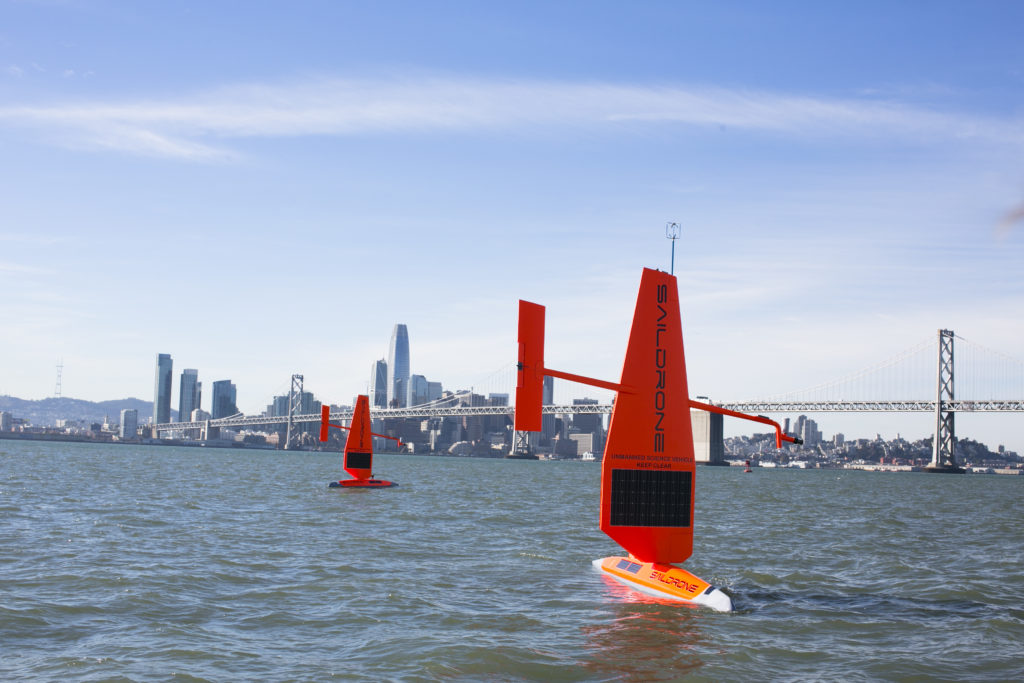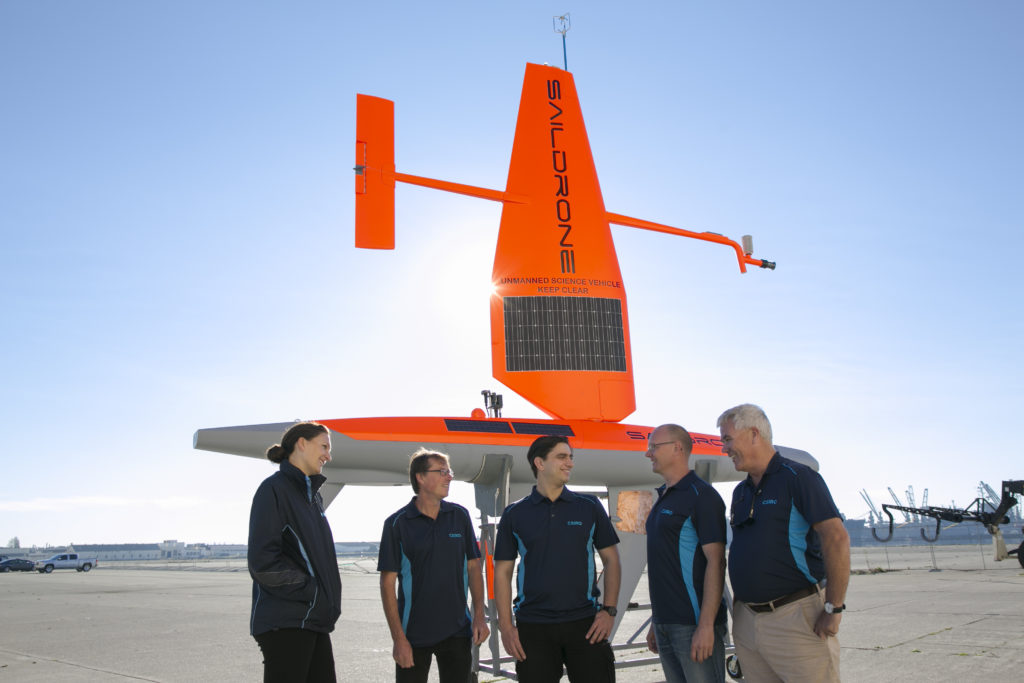
Two Saildrones seen sailing in the water. Buildings are visible in the far distance.
The research partnership over five years between Saildrone and our Oceans and Atmosphere team will see the deployment of state-of-the-art unmanned ocean surface vehicles, Saildrones, for the first time in Australian waters.
UPDATE 23/3/2018: Our Saildrone fleet was unveiled in Hobart today, before setting off on a mission to capture valuable ocean data. Find out more here.
When you think of the role automation could play in your life you probably think of the latest fridges that plan your meals, having a chat with Google home, or maybe what life will be like working side by side with robots.
But have you ever thought about how automation is changing the way we collect ocean and climate data? Well wonder no more! The ocean technology industry is booming, with new devices, moorings and vessels coming online to plug gaps in how we collect these data across the world.
Many oceans to cross
Think about it – 71 percent of the Earth’s surface is covered by oceans. We know that the oceans control our climate through absorbing around 90 percent of heat energy from our skies and around 25 percent of the greenhouse gases emitted to the atmosphere. Oceans are also fundamental to our lives – they provide much of the food we eat plus 50 percent of the oxygen we breathe!
Getting around to study all of our oceans is quite a challenge. The Southern Ocean in particular covers about 20 percent of the area of all oceans and presents a unique challenge for scientists. This is one of the most important regions on earth for removing heat and carbon dioxide from the atmosphere and is undergoing ocean acidification, warming and circulation change that can impact ecosystems and influence rates of climate change. Rough seas and the small number of vessels which pass through this region (mostly in the summer months) limit our ability to detect change and understand the driving processes needed to predict the future state of the Southern Ocean and our climate.
For the coastal and regional seas around Australia, observations are also limited to a small number of sensor-equipped ships or moorings. There are few if any data that can be used to identify key changes in the marine environment which are similar to those occurring in the Southern Ocean. These data are needed to determine change or stress points and the consequences for our oceans and ecosystems.

We’re working with San Francisco-based ocean technology start-up, Saildrone, to radically improve measurement and monitoring in Australian waters and the Southern Ocean.
We’re working with San Francisco-based ocean technology start-up, Saildrone, to radically improve measurement and monitoring in Australian waters and the Southern Ocean.
Self-sufficient Saildrones
We recently announced a partnership with San Francisco based ocean technology start-up Saildrone to introduce a fleet of revolutionary ocean vessels into Australian waters and the Southern Ocean.
The use of Unmanned Surface Vehicles (USVs) around Australia and in the Southern Ocean represents a huge technological leap in our capacity to monitor and observe the ocean, allowing scientists to develop a deeper understanding of how our ocean works.
Saildrones are solar and wind powered USV platforms that can go to sea for 12 months without returning to dock. Whilst at sea Saildrones can continuously collect information about temperature, salinity and carbon, sending data back to researchers via satellite.
The USV fleet can also be re-tasked quickly, providing a new way to measure ocean conditions associated with events like marine heat waves or toxic algal blooms. In the past it would have required extensive planning and expense for a ship and crew.
The team from Oceans and Atmosphere are collaborating with Saildrone to equip the vessels with some specialised equipment developed in house. The initial suite of sensors measures meteorological conditions, sea temperature, salinity, carbon dioxide, pH, oxygen, acoustics for fisheries research, and optical sensors are used to estimate plant biomass. Other sensors may be added to enhance capability as the partnership progresses.


23rd February 2018 at 9:54 pm
I agree with each of you, however, the main problem for all sensors is their calibration and timely service. Fouling is a real scourge for all sea-going ships, therefore, it is necessary to improve the technology in such a direction, so as to depend less on external interference, leading to interference of the results.
9th February 2018 at 8:52 am
Excellent innovation. Do the saildrones have the capability to avoid collisions with other marine craft?
3rd February 2018 at 2:52 pm
Can they be controlled and bright back to a base?
6th February 2018 at 9:17 am
Hi Maurice,
The Saildrones can be remote controlled from anywhere and can be brought back to base at any time.
Cheers,
Eliza
CSIRO social media team
26th January 2018 at 10:32 pm
Sounds like a great beginning, and hopefully they can be used in the future for lots of biological/ ecological monitoring.
26th January 2018 at 3:31 pm
Innovative design.